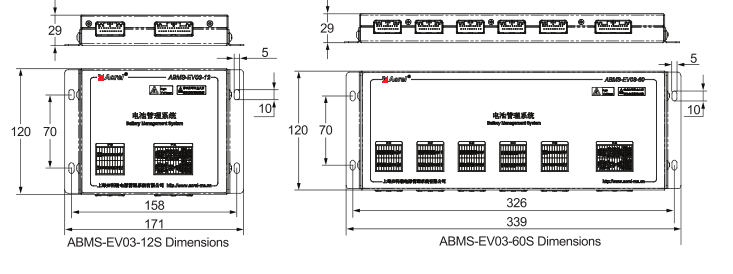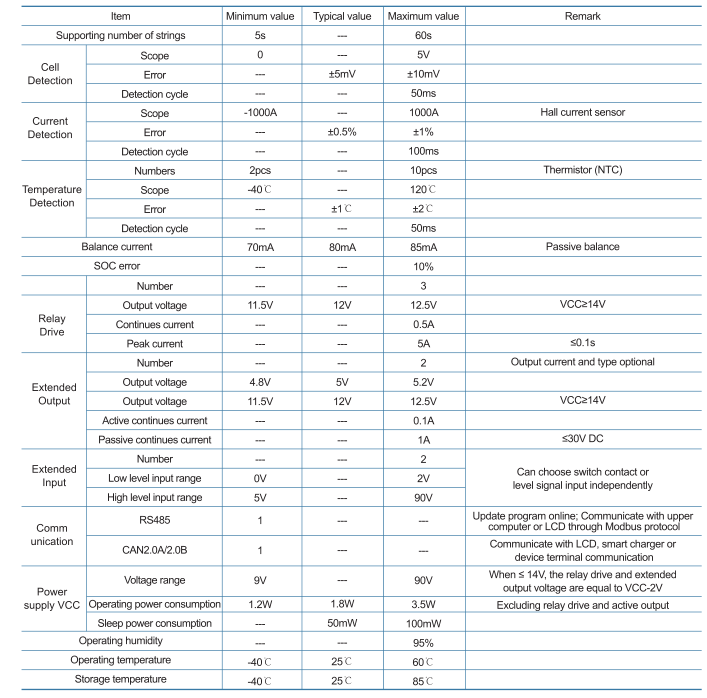

1.Introduction
The product applies to 5-60 series LiFePO4, Li(NiCoMn)O2, LiMn2O4 and other Lithium battery packs.
ABMS-EV03 series battery management system adopts all-in-one architecture, which is widely used in low-speed Electric Vehicles, Logistics Vehicles, Forklift Trucks, AGV , Teaching Equipment and energy storage system. Perfect functions, reliable performances, rich input and output interfaces, can fully satisfy these projects demands.
The detection system adopts the management chip of imported brand LT, which is used to monitor the data of each battery cell of voltage, current and temperature in real-time, it can also quickly analyze and process the data, so as to prevent the faults such as over-charge, over-discharge, over-current, over temperature. Then the batteries can be used safely, effectively and long.
The power supply mode is flexible. Firstly, the DC 9V~ 90V wide voltage range is satisfied, the total pressure power supply of the battery can be supplied, others the DC12V/ 24V auxiliary power supply can also be adopted; Secondly, two power supply ports are available: the battery total voltage or the auxiliary power supply port and the charger auxiliary power supply port. It has the self-power-down function, when the idle time reaches the set value, or when the core voltage reaches the low protection voltage value, the BMS will automatically shut down and sleep.
2. Features
l Adopts a modular design to support the protection of 5-60s battery pack;
l Detect cell voltage, temperature and current data of the cells in real time;
l Detect and handle alarming situations, such as over-charge, over-discharge, over-current, over-temperature and others;
l SOC calculation;
l The intelligent balance will make the consistency of the battery pack achieve the best effect, and also can improve the efficiency life of the battery;
l Support CAN and RS485 communication;
l Three-way electric relay driving;
l Flexible power supply mode, wide voltage input range, intelligent sleep, low static power consumption;
3.Functions
Charging management of battery pack:
In order to adapt diverse charging scenarios, BMS offers a variety of solutions.First, when charging a battery pack using a common charger without a communication function (commonly known as blind charging), BMS directly controls the charging relay closed or open to realize the charging status according to data such as battery voltage, temperature and current.
Second, when intelligent charger with CAN communication is used for charging the battery pack, real-time communication and exchange data between BMS and charger can be realized, starting or stopping of the charging are controlled by the charger, and parameters such as the charging voltage and the charging current can be limited. It is also possible to control the charging relay closed or open to realize charging status by BMS.
Third, partial chargers contain auxiliary power supply (usually DC 12V or 24V) output function, which can be used to power the BMS charger auxiliary power port (VCC-CHG + and VCC-CHG-). After the charger starts to work, the auxiliary power supply normally outputs DC 12V or 24V power, and BMS can be automatically turned on to charge the battery pack, and ACC electric lock switch is not required to be turned on. After the charging is completed, the charger powers off and BMS automatically work into sleep status.
Discharge management of battery pack:
Similarily, BMS provides a diversified discharge management solutions.
First, in general applications, BMS directly controls the relay closed or open to control the discharging based on data such as battery voltage, temperature and current.
Second, the motor controller or other discharge monitoring device can read the operating parameters and status of the battery system in real time through RS485 or CAN communication interface of BMS, then make effective and reasonable discharge management so as to ensure the operation of battery system safety and stability. When BMS determines that the battery system needs to prohibit discharge, and the motor controller or other discharge monitoring device does not make an effective control, the battery discharge is inhibited by controlling the discharge relay open .
Thermal management of battery pack:
According to the requirement of actual application to the heating or air cooling control of the battery pack, when the temperature of the battery pack exceeds a limit value, the heater or the fan will start to realize the thermal management function of the battery pack through the extended output interface.
Power balance:
When a certain series of cell voltage and temperature are detected to satisfy the setting conditions, BMS turns on or off the electric balance of the certain cell. By adopting the passive balance, the equalization resistance is used to consume the surplus power, thereby improving the consistency and efficiency of the battery pack effectively.
Communication interface:
BMS provides a RS485 and CAN2.0A/ 2.0B interfaces independently. BMS can connected with PC upper computer software to query, set and record historical parameters, and can also be used as communication interface between LCD or other equipment terminal via RS485 port of Modbus protocol. Others BMS can communicate with intelligent charger to set charging voltage and current, it also can connect with LCD or other terminal equipments via CAN port.
4.Dimension(Unit:mm)

5.Technical Features
